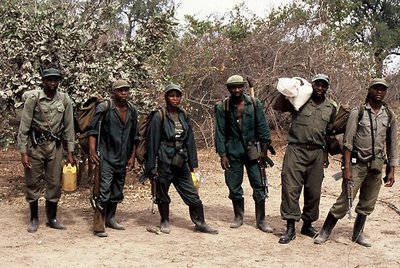AN investigation by the Oxpeckers Centre of Investigative Environmental Journalists revealed that the Zambezi Region, where five SADC countries, Angola, Botswana, Zambia and Zimbabwe intersect with Namibia is a smuggling hotspot.
With more than 9 100 residential elephants and 30 000 migrating elephants according to 2013 data, elephant poaching was not a serious issue in the trans-border area until recently. However, in 2012 the situation changed, with at least 78 elephants poached by international smugglers in one year. By November 2013, official records showed that at least 20 elephants had been poached since the start of the year, and 35 smuggling suspects had been arrested.
According to Shadrick Siloka, chief warden in the Ministry of Environment and Tourism (MET) office of Katima Mulilo, a Chinese man was mentioned that apparently plays an important role as middleman in the smuggling trade. Siloka said that the name of Guo Yunhui, a Chinese businessman in Katima Mulilo keeps turning up as far as ivory smuggling is concerned. In 2010, the MET heard from informers that Guo was collecting pythons and pangolins. In 2011, Guo was arrested for buying two ivory tusks from MET staff, fined N$20 000 and released.
Zheng, a Chinese construction worker near Katima, claims Guo is still engaged in the wildlife smuggling business. Chen, a Chinese businessman in Rundu, also confirmed that Guo is active in the business.
Guo may not be the largest player in the Zambezi ivory market, according to Li, a leader in the Chinese Fujian business community of Namibia. Li referred to another Chinese man in Katima Mulilo, who he said was found by police in early 2013 with more than 100kg of ivory, but MET said it did not know about the case.
The Chinese community members are reluctant to blow the whistle on the larger ivory smugglers, and alleged involvement by Chinese diplomats themselves.
In Katima Mulilo, it is common for Chinese people to be approached by African ivory sellers, mostly Zambians. The MET officials confirmed that the price Guo paid to the sellers of ivory was N$300 per kilo, whereas in Asia the selling price is at least US$3 000 per kilo.
“In 2012 the amount of ivory we captured was 70% to 80% of the amount of ivory taken from poached elephants in Namibia,” said Morgan Saisai, the chief control officer of MET in Katima Mulilo.
According to the Chinese, the chance of ivory being discovered by airport customs in Namibia or China is very low, and even when it is found, the consequences are not severe.
On Monday, three Chinese nationals were arrested at the Hosea Kutako International Airport while in possession of 14 rhino horns in luggage. The trio, Li Xiao Liang (30), Li Zhi Bing (50) and Pu Xu Nin (49) appeared in court on Tuesday and were remanded in custody. They will appear again in court next week Wednesday. They are said to have travelled to Namibia from Zambia, and enterered through the Zambezi Region’s Wenela border post. They were about to fly to Johannesburg when they are arrested.

 JOIN DRIVERN TAXI AS PARTNER DRIVER TODAY!
JOIN DRIVERN TAXI AS PARTNER DRIVER TODAY!











